
Home
Services
About us
Blog
Contacts
Mobile App Development for Staffless Hotels: The A‑Bots.com Blueprint
The Rise of Staffless Hospitality: Mobile‑First Hotels Take Center Stage
Designing the Guest Journey: From Instant Booking to Contactless Check‑Out
Under the Hood: Cloud‑Native Architecture and IoT Integration Stack
Operational Control Center: Automating Housekeeping, Maintenance and Energy
From Prototype to Launch: A‑Bots.com Development Methodology and Proven Track Record
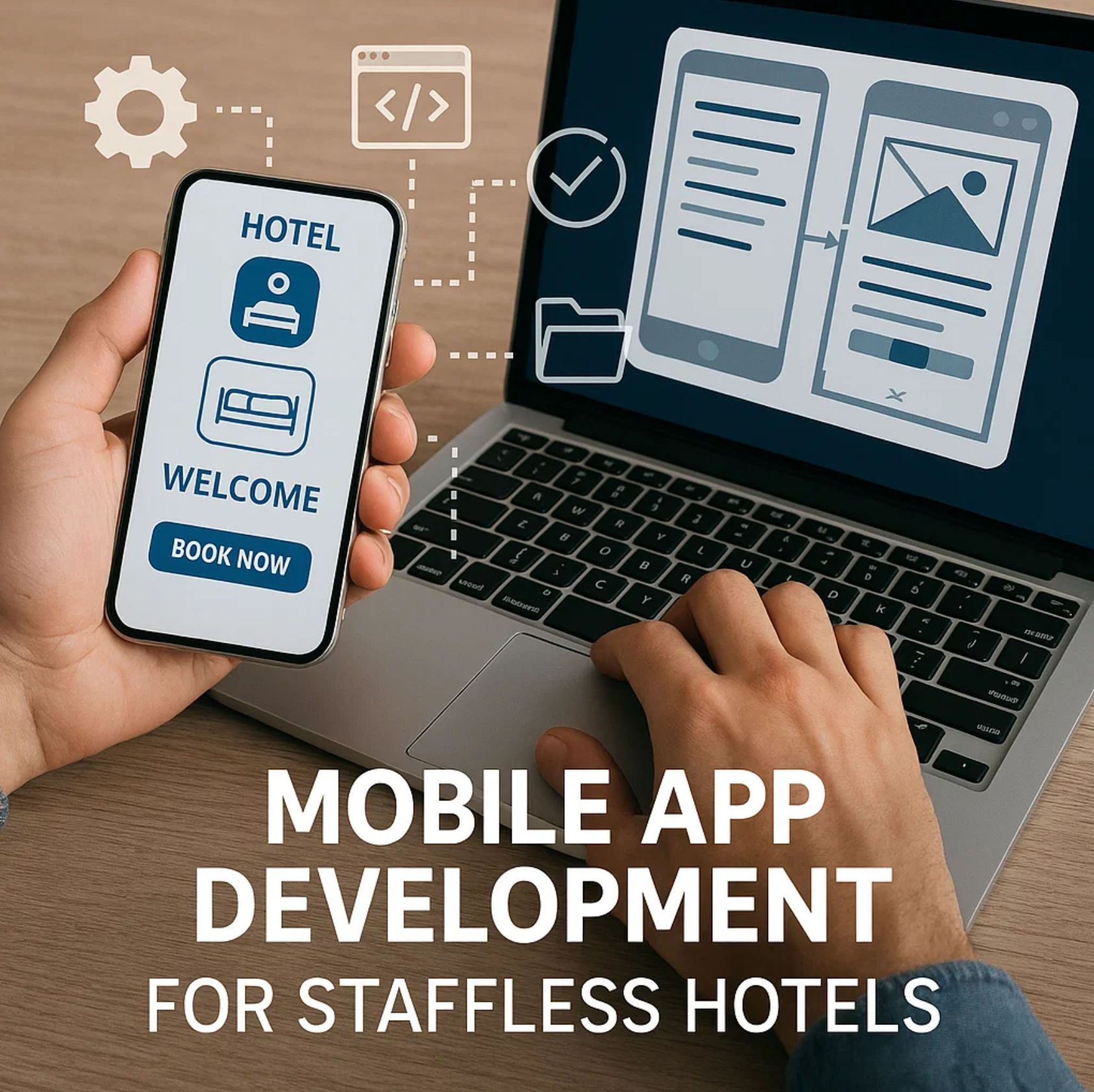
The Rise of Staffless Hospitality: Mobile‑First Hotels Take Center Stage
Just after midnight in Lisbon a solo business‑traveller taps her phone, watches a green light sweep across the door handle, and steps straight into a neatly lit room. No night receptionist, no paper forms, no keycard to misplace—only the quiet hum of a perfectly timed air‑conditioning unit and a welcome message on her screen. Scenes like this were once the domain of futurist concept videos; in 2025 they are becoming everyday practice for a fast‑growing category of staffless, mobile‑first hotels.
From contactless gimmick to operational backbone
Three converging currents are carrying the model into the mainstream. First, travellers themselves have moved decisively onto mobile. Across Europe last year, a commanding 77 % of online hotel bookings originated on OTAs’ mobile channels, a share that continues to edge upward each quarter. Small independents no longer have the luxury of debating whether an app matters; their guests arrive already conditioned by Booking.com or Airbnb to expect instant, tap‑to‑confirm workflows.
Second, the guest journey inside the property is now credibly app‑centric rather than “mobile‑adjacent.” Hilton’s brand data provide a striking benchmark: in just the first eight months of 2023 guests downloaded 12.3 million Digital Keys and shared another 800 thousand with travel companions, turning the phone itself into the default doorway credential for a global chain that once issued only plastic cards (Stories From Hilton). That adoption rate—on hardware Hilton does not subsidise for its users—suggests that smaller operators can leapfrog legacy access systems altogether if their software experience is polished and trusted.
Third comes the hardware revolution that makes staffless possible outside a laboratory. The U.S. smart‑lock market alone, valued at roughly US $766 million in 2023, is forecast to compound at 16 % annually through 2030, powered not just by residential demand but by hospitality‑grade devices that integrate Bluetooth Low Energy, NFC, and remote audit features as standard (grandviewresearch.com). Smart locks mesh naturally with occupancy sensors, minibar weight pads, and AI‑assisted CCTV analytics, creating a layer of machine awareness that can flag an unlatched housekeeping door before a human ever walks the corridor.
Why small properties go staffless first
It is tempting to view staff‑light operations as a big‑brand luxury, yet the economics tilt most strongly in favour of the sub‑100‑room segment. Labour remains the single largest expense line for hotels worldwide—north of thirty cents on every revenue dollar in the United States even after aggressive post‑pandemic head‑count trimming. A boutique property cannot absorb the fixed cost of a round‑the‑clock front desk without eroding its ADR; an owner‑managed guesthouse in the Alps certainly cannot. Replacing three shifts of receptionists with a well‑designed mobile app is less about futuristic flourish than simple survival in wage‑inflation economies.
Moreover, independent hoteliers face an operational paradox: they must deliver higher perceived service levels with fewer bodies on site. A cloud‑native app turns that problem into a software challenge. Real‑time dashboards show which rooms are vacant but power‑hungry, which fridges need a Prosecco top‑up, or whether a leaked tap has triggered the utility’s high‑flow alert. Push notifications can summon an on‑call contractor only when predictive models flag a genuine anomaly, freeing owners from the expensive safety net of salaried generalists “just in case.”
The guest experience imperative
Guests, for their part, rarely miss the marble counter once they taste the speed of a zero‑line check‑in. Industry surveys link mobile keys to double‑digit lifts in Net Promoter Score, and in‑app messaging resolves minor problems—extra towels, a pillow preference—without the friction of waiting to “speak with someone.” Younger leisure travellers, raised on same‑day Delivery apps, interpret delayed responses not as quaint hospitality charm but as systemic failure. Conversely, a prompt chatbot reply—ideally escalated to human support only when sentiment analysis senses frustration—feels more personal than reciting passport details in a lobby queue.
A blueprint written in code
All of this converges on the same strategic question: who writes the app, stitches the APIs, hardens the security, and iterates fast enough to keep pace with guest expectations? That is where the keyword at the heart of this article—mobile app development for hotel—meets the practical reality of shipping production software. A‑Bots.com specialises in wrapping complex device ecosystems into a single, brand‑aligned application, whether the inventory is ten loft rooms above a café or fifty cabins straddling a coastal trail. Their engineers treat lock firmware, payment gateways, PMS webhooks, and GDPR compliance as one contiguous puzzle rather than siloed “IT bits,” so owners see a dashboard rather than a patchwork.
Looking forward
Staffless hospitality is not an experiment waiting for consumer acceptance; the consumer is already there, phone in hand, keyless entry set as default. What lags, especially among independent operators, is the willingness to trust software as the nervous system of the property. Yet the numbers argue persuasively: millions of digital doors opened, smartphones dominating the booking funnel, and hardware markets racing ahead to accelerate the trend. For the small‑property entrepreneur the question is no longer whether to build an app, but how quickly and with which partner to seize the mobile‑first mantle before the next boutique competitor does.
From here the discussion will dive deeper—first into the granular guest journey, then into architecture, operations, and finally into the method A‑Bots.com uses to turn vision into a working release. For now, the rise of staffless hospitality should be clear: it is powered by code, unlocked by hardware, and already knocking at your (digital) door.
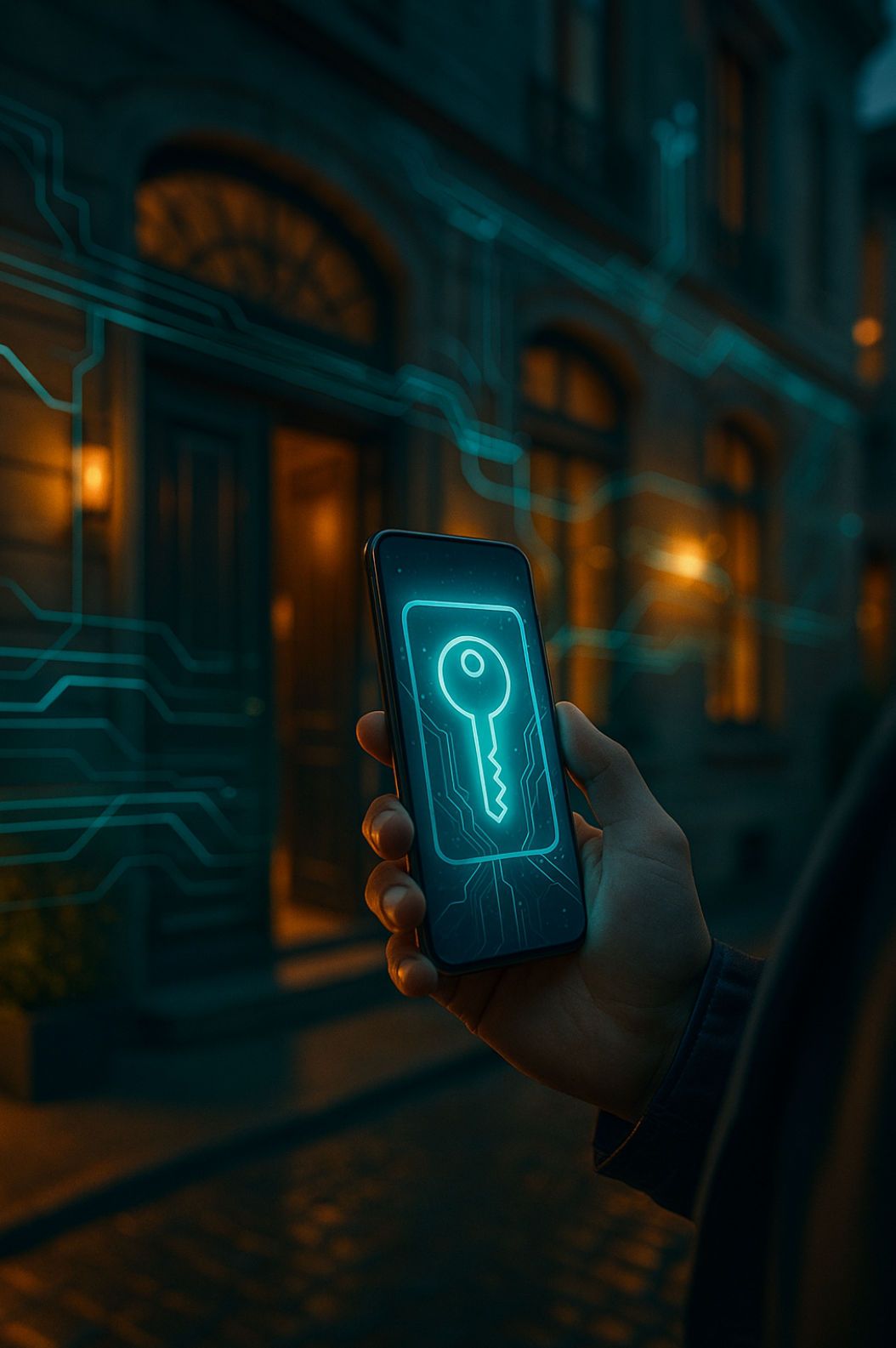
Designing the Guest Journey: From Instant Booking to Contactless Check‑Out
A first‑time visitor discovers the hotel in a late‑night Google search, taps an ad that promises “no front‑desk lines—ever,” and is propelled straight into the branded app’s booking screen. Within thirty seconds she has chosen a river‑view room, scanned her Apple Pay face‑ID, and received an animated confirmation that doubles as a micro‑tour: a swipeable series of cards explaining digital keys, in‑app support, and a self‑guided local walking route. That compressed flow—search, choice, payment, orientation—encapsulates the philosophy of mobile app development for hotel experiences built for staffless operations: every step must either disappear entirely or become so effortless that it feels like an extension of the user’s existing digital habits.
From discovery to door unlock in four invisible stages
The journey begins well before arrival, in the “invisible lobby” of the app store listing and social proof. Because boutique hotels lack the marketing budgets of major chains, their mobile storefront must compensate with instantaneous trust signals: live review scores piped from the PMS API, transparent cancellation rules, and a short‑loop teaser of the room that actually awaits the guest—recorded with yesterday’s date stamp to prove topicality. Once that hurdle is cleared, the booking widget becomes the first real crucible of design. Card capture, ID verification, and currency conversion cannot feel like discrete tasks; the code has to treat them as background services that resolve themselves while the guest chooses pillow firmness and minibar mood presets. A‑Bots.com accomplishes this by embedding PCI‑compliant vaulting inside a single React Native component, so the first checkout never asks twice for the same field and subsequent stays complete with a single biometric tap.
Pre‑arrival is next, and here a hotel’s app has the chance to turn an inevitable waiting period into brand value. Instead of generic reminder emails, guests receive a dynamic timeline: public‑transport options plotted on a map that updates with regional delay data, weather‑triggered packing tips, and a push prompt asking if they’d like the room temperature set two degrees cooler. For special‑access properties—say, an ancient building with a narrow entry—the preload also serves to demystify logistics. A fifteen‑second video shows how the street door’s smart lock works, cueing the exact LED colour they should expect when the Bluetooth handshake succeeds. Anxious travellers therefore arrive with the procedure already rehearsed, removing one of the most common friction points of staffless stays.
Check‑in itself collapses to a moment so brief it is easy to underestimate its architectural complexity. The instant a guest crosses a geofence fifty metres from the façade, the app attempts a silent token refresh with the cloud PMS; if the room is ready, an encrypted mobile key downloads in the background and a notification lights up. Should housekeeping still be inside, the animation turns yellow instead of green and the guest is nudged toward the lobby café, with a complimentary drink voucher materialising in the wallet. All of this requires millisecond‑level choreography between access‑control firmware, occupancy sensors, and the hotel’s payment ledger, because the token must not issue until the folio is cleared and the room flagged clean. A‑Bots.com’s middleware maps each subsystem—smart lock, housekeeping dashboard, payment gateway—into a unified event bus so that edge cases are resolved in software rather than in panicked phone calls.
During the stay, the app graduates from key to concierge. A floating action button anchored in the bottom‑right corner opens a natural‑language chat that pulls intents into three backend services: maintenance for anything that sounds like “leak,” F&B for minibar requests, and general help for the rest. If a guest types “Where can I get another towel?”, the NLP layer generates a staff task in the housekeeping queue; when the staffer scans the QR code outside the room door to confirm delivery, the customer’s chat thread automatically marks the issue resolved. The entire exchange may occur without a single spoken word, yet the guest perceives attentive service, because latency is the new politeness metric. More importantly for a staffless hotel, the owner does not have to keep a receptionist on site; a single roving attendant with a phone can satisfy real‑time requests across three floors.
The departure moment often loses design attention, but in staff‑light properties it is pivotal to brand loyalty. When the guest lingers past breakfast, the occupancy sensor knows she is still inside; at 11:53 a.m. the app generates a gentle nudge: “Need more time? Approve late check‑out until 14:00 for €15.” If she swipes “Yes,” the PMS closes the upsell loop, updates housekeeping rosters, and extends the mobile key without manual override. If she ignores the prompt and leaves by noon, the door’s accelerometer registers exit, triggers auto‑checkout, and emails the invoice before the taxi reaches the airport slip road. That friction‑free goodbye transforms what might have been a tense knock from housekeeping into a digitally mediated courtesy, reinforcing the idea that self‑service can feel like premium service.
Throughout these phases the guiding principle is coherence. A guest should never bounce from app to browser to reception phone; nor should an owner find themselves juggling siloed dashboards. By insistently collapsing functions into a single mobile surface, the staffless model proves that hospitality’s warm welcome can, in fact, be written in code—even when no human hand is there to pass the key.
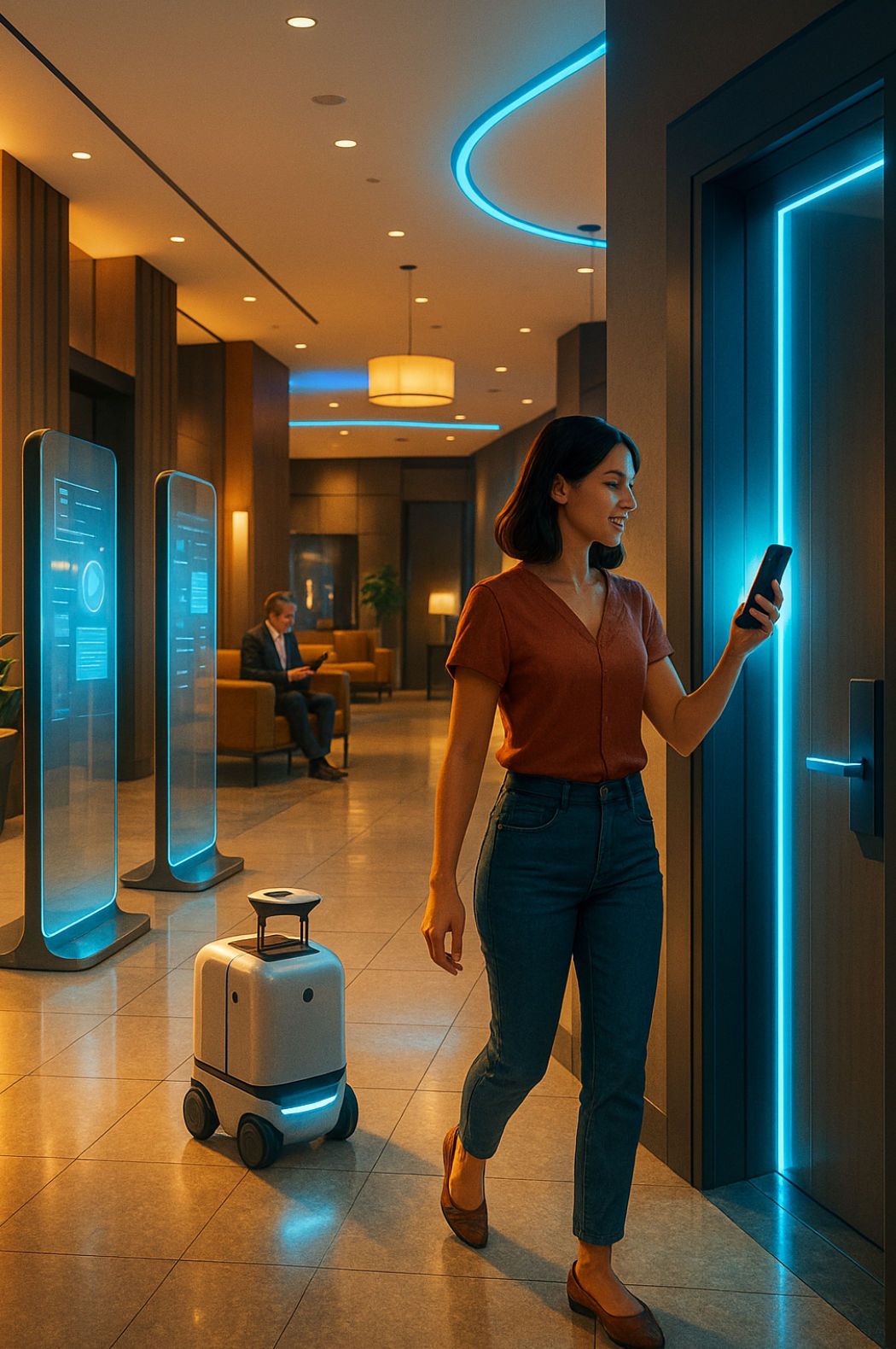
Under the Hood: Cloud‑Native Architecture and IoT Integration Stack
Pull back the polished interface of a staffless hotel app and you find a living organism of services, sensors, and security layers, synchronized to milliseconds. For mobile app development for hotel projects, the core challenge is not writing a pretty React Native screen but building an infrastructure that can unlock a door in under 200 ms on a shaky rooftop LTE signal, while simultaneously posting a ledger entry, updating housekeeping, and logging an audit trail that satisfies GDPR. A‑Bots.com tackles that challenge with a cloud‑native blueprint whose components—though invisible to guests—decide whether the entire staffless promise holds.
The beating heart: a cloud PMS extended by event streams
Everything starts with a modern property‑management system that exposes real‑time webhooks rather than nightly batch exports. Reservation events, folio updates, and profile changes stream into a message bus (Kafka or NATS depending on scale), instantly fan‑out to micro‑services, and create the single source of truth. Because the bus carries immutable events instead of mutable rows, downstream services can replay history to debug anomalies—a crucial feature when a door fails to open at 2 a.m. and the audit clock is ticking. Ingest latency hovers around 20 ms inside the same region; cross‑region replication protects against a zone outage without dragging performance below the psychological “tap‑response” limit.
Doorway to the edge: smart locks, BLE beacons, and predictive caching
Smart‑lock traffic never takes a scenic route through distant data centers. A‑Bots.com places a lightweight edge gateway—often a Raspberry Pi Compute module or AWS IoT Greengrass node—inside the hotel network. When the mobile app crosses the geofence, it requests a time‑boxed credential. The gateway pre‑caches the next two hours of valid tokens with AES‑256 wrapping; if the WAN link drops, the lock still authenticates locally, maintaining the illusion of omnipresent connectivity. Telemetry flows the other way: every unlock, latch status, or tamper alert emits an MQTT message that races back to the cloud for analytics. In 2024 Hilton reported 12.3 million such mobile unlocks across its estate; boutique properties may see hundreds per day, but each must round‑trip in under 150 ms to feel instantaneous, and the edge pattern delivers exactly that.
Sensor lattice: occupancy, energy, minibar, maintenance
Beyond the lock, a lattice of Zigbee and Wi‑Fi sensors feeds the same event bus. Occupancy PIRs toggle HVAC set‑points, minibar weight pads spot missing champagne splits, leak detectors alert maintenance before the guest notices damp carpet. Because every signal is timestamped and tenant‑tagged, a graph database can infer complex states—“room 208 checked out, minibar unbilled items zero, linen swap complete, door closed”—and auto‑hand the room to housekeeping in a Kanban lane. Energy dashboards translate those events into kilowatt curves; studies show IoT‑driven HVAC optimisation trimming as much as 20 % off annual utility spend, a meaningful buffer when labour savings are already banked.
Security spine: zero‑trust tokens and defence in depth
Moving money, keys, and personal data through the same pipe demands uncompromising security. At the network edge mutual‑TLS terminates in Envoy sidecars, stripping the need for inbound ports on individual containers. App users authenticate via OAuth 2.0 and OpenID Connect; room‑level keys derive from an HSM‑backed key‑management service and expire on checkout or 24 hours, whichever first. PCI‑DSS Level 1 gateways tokenise card data before it ever touches hotel servers, while differential‑privacy bursts randomise telemetry so heat‑maps cannot be traced to a named guest. Penetration testing rides the CI pipeline; failed scans break the build, enforcing security parity with big‑brand chains even for a ten‑room lodge.
Continuous delivery and operability
Containers orchestrated by Kubernetes form the deployable units. Blue‑green rollouts shift traffic only after health probes confirm that a new build can still convene a lock handshake in test. Prometheus scrapes metrics—door‑latency histograms, memory pressure, housekeeping job lag—and Grafana dashboards light up in the owner’s back office. Should latency spike above 300 ms, an autoscaling policy spins additional pods; if MQTT throughput dips, the gateway queues until the uplink stabilises, guaranteeing delivery. That self‑healing loop lets a single dev‑ops engineer oversee dozens of properties, reinforcing the staff‑light ethos from the server room outward.
API glue and third‑party ecosystems
No hotel is an island, so the architecture exposes secure APIs for upsell engines, revenue‑management algorithms, or loyalty platforms. GraphQL shields internal schemas while granting partners narrow, role‑scoped windows into availability or spend. A‑Bots.com’s SDK abstracts the complexity; a developer toggles “minibar” or “key share” modules and receives boilerplate that handles state reconciliation and offline queuing. Such composability shortens pilot cycles: a coastal micro‑hotel swapped a legacy lock vendor for an NFC‑enabled alternative in a single sprint, redeploying guests’ digital keys with zero app‑store downtime.
The takeaway
Underneath the graceful swipe‑to‑unlock gesture lies a rigorously engineered stack that treats every hotel device as a first‑class citizen of the cloud. It is this tapestry of event streams, edge gateways, and hardened tokens—not just the visual polish—that determines whether staffless hospitality feels magical or maddening. For owners evaluating mobile app development for hotel ambitions, understanding the interplay of cloud‑native patterns and IoT realities is crucial; selecting a partner who already writes that complex score is decisive. A‑Bots.com’s architecture, battle‑tested across smart‑building and consumer‑IoT projects, supplies the orchestrated backbone that allows boutique properties to greet guests with code rather than counters—proving that, in hospitality, the most welcoming lobby may be the one you never see.
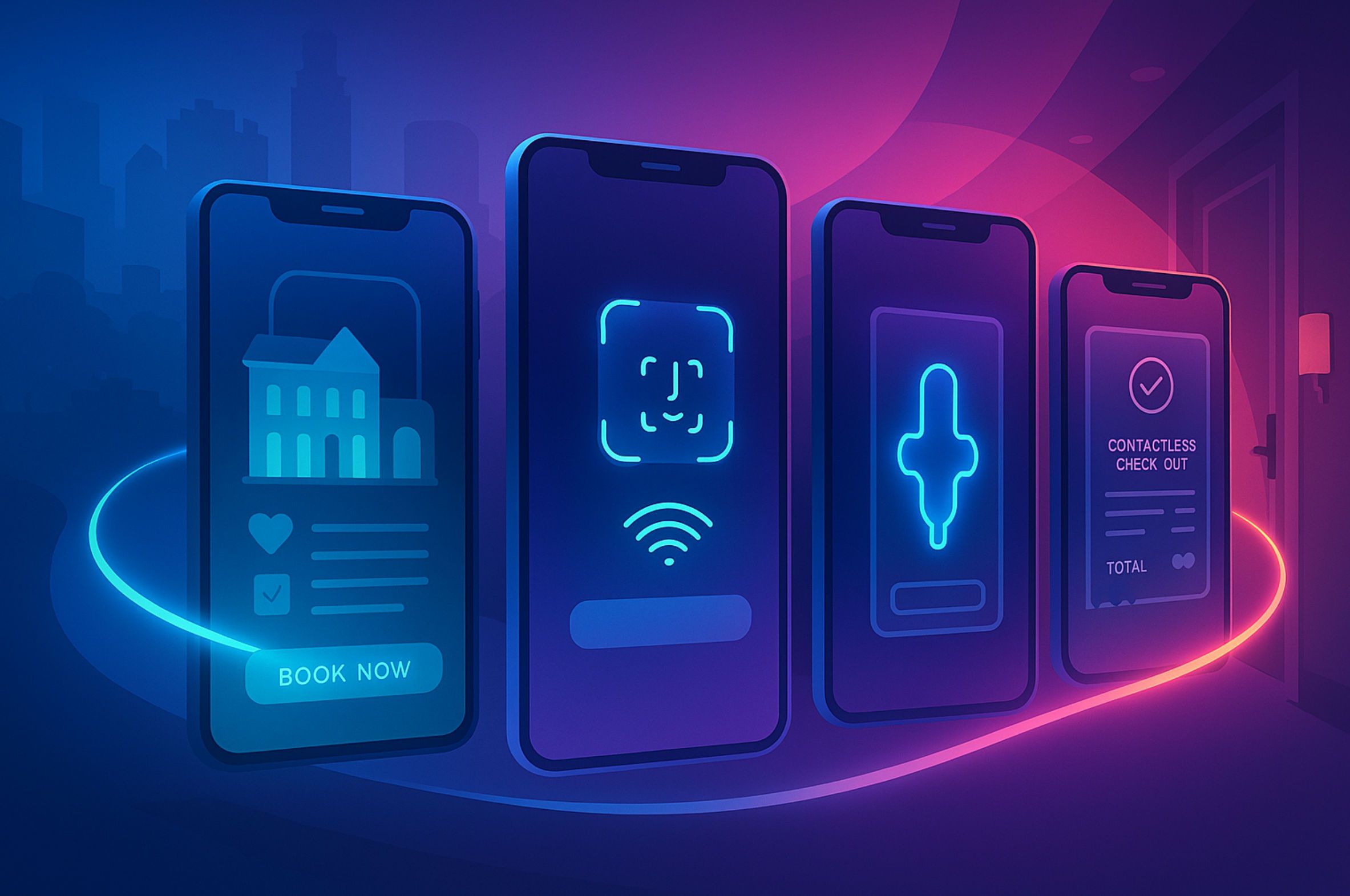
Operational Control Center: Automating Housekeeping, Maintenance and Energy
Walk into the back office of a staffless hotel and you will not find a wall of whiteboards or a stack of walkie‑talkies. Instead, you will see a single screen where coloured tiles glide from “Vacant–Dirty” to “Vacant–Clean”, air‑conditioning icons pulse green or amber, and a leak alert occasionally flickers red before vanishing when a plumber confirms the fix. This live tableau is the Operational Control Center—the nerve‑hub that lets an owner manage a property without a resident general manager or full‑time reception, and it is the element that transforms mobile convenience into sustainable daily practice.
The centre’s first mission is to tame the labour line‐item that still consumes about 32 % of gross revenue in U.S. hotels — higher at service‑heavy boutiques. Because every guest interaction already flows through the app, the dashboard can orchestrate staff only where hands are essential. When a checkout event hits the property‑management stream, the room tile slides into a “dirty” column that appears simultaneously on the housekeeper’s phone. A swipe after final inspection propels it to “clean” and triggers a push notification so the arriving guest’s mobile key downloads the moment the lift doors open. No radio calls, no duplicated logs; a single queue replaces what three shifts of receptionists once coordinated.
Maintenance tasks spin out of the same event lattice, but rather than relying on human observation they arise from sensor telemetry. A humidity spike under a vanity unit signals a potential leak; the system cross‑checks booking data, sees the guest is at dinner, and dispatches an external contractor who carries contractor‑grade mobile credentials. Tap replace completed, the technician scans a QR sticker; that single action closes the job, updates the asset ledger, and resets the alert threshold. Minor faults that would otherwise fester into guest complaints convert into silent micro‑interventions.
Energy oversight is where the control centre pays its own electricity bill. Smart HVAC compressors and occupancy sensors cooperate to shave load while preserving comfort. When the last smartphone exits a room’s geofence, the thermostat eases toward an eco‑set‑point; the moment the digital key re‑enters, temperature and lighting swing back. Industry studies peg the resulting utility reduction at up to 20 %, with many sites reporting payback inside two years. The dashboard visualises these kilowatt dips in real time, letting the owner brag—and benchmark—against yesterday’s performance.
What sounds like sorcery is really the predictable outcome of marrying event‑driven software with IoT hardware. A‑Bots.com wires every subsystem—locks, mini‑bars, boilers, blinds—into an event bus where each datum is time‑stamped and immutable. That architectural choice means the control centre never asks “What is the room state?”; it knows, because state is a projection of the latest events. Should anomalies appear—say, a minibar door left open for twenty minutes—the system does not merely log the fact; it calculates the probable temperature rise, anticipates spoilage, and can nudge the guest via in‑app chat before a warm Prosecco ruins the surprise.
Such predictive capacity extends to staffing rosters. By analysing historic cleaning duration versus occupancy patterns, the software forecasts the exact hour additional housekeepers will be needed after a city‑wide conference departs. Owners accustomed to spreadsheet guesswork find themselves redeploying staff with airline‑style precision, an efficiency gain that matters more than ever in tight labour markets. The beauty is that the frontline employees who remain can focus on hospitality touches—flower vases and turndown chocolates—rather than status‑checking clipboards.
Security and compliance sit beneath the visuals but inform every button click. Because personal data, entry logs, and payment tokens converge in one ecosystem, A‑Bots.com enforces a role‑based access model derived from zero‑trust principles. Housekeepers see only task lists; maintenance vendors see only the devices they are authorised to touch. Failed login attempts flag immediately, and any override—such as a master key issuance—generates an immutable audit record. The owner can travel continents away, open the mobile console, and assure themselves that every digital skeleton key remains sheathed.
Sceptics sometimes fear that automation strips hotels of their soul. Yet owners running the control centre often discover the opposite: because the routine chores disappear into software, precious human bandwidth remains for gestures that feel more personal. A single attendant can greet arrivals in the lobby café, armed with real‑time guest preferences. When a vegan family checks in, the dashboard prompts the café to swap the complimentary pastry; when a repeat business traveller lands at 2 a.m., the night‑mode script dims corridor lights and queues a light snack in the smart fridge.
Ultimately, the control centre is the operational contract that turns staffless theory into lived reality. It distils thousands of sensor pings and guest gestures into an intelligible, actionable surface. Hotels that master this layer discover they no longer run on hope and ad‑hoc WhatsApp groups; they run on data, automation, and intentional human touchpoints. For anyone pursuing mobile app development for hotel ambitions, understanding—and demanding—such a control centre is non‑negotiable. It is not a dashboard tacked on at the end; it is the spine. And with A‑Bots.com architecting that spine, small properties gain a command bridge powerful enough to rival the tech stacks of global chains while preserving the intimate vibe that first drew guests to boutique lodging.
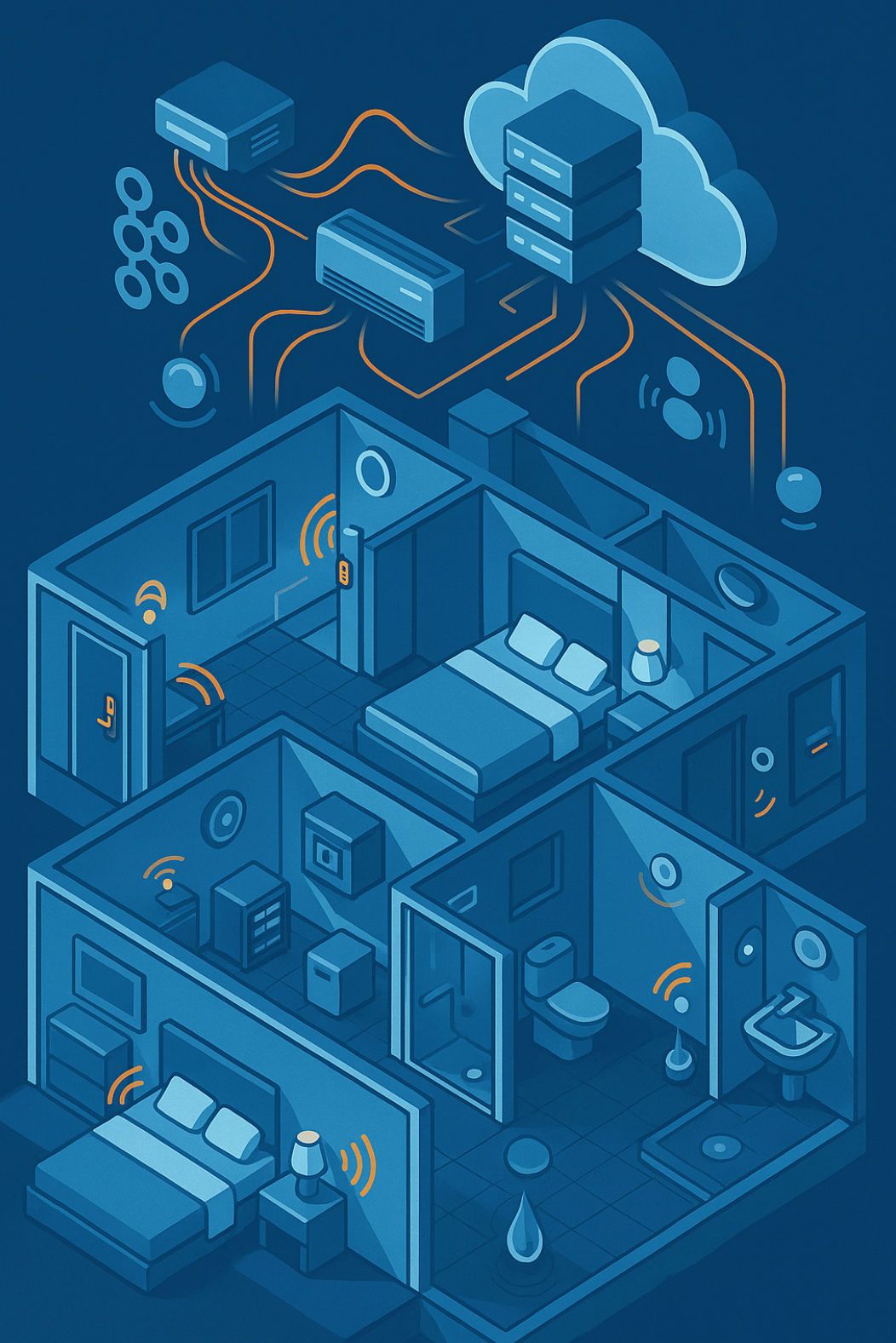
From Prototype to Launch: A‑Bots.com Development Methodology and Proven Track Record
For an independent hotelier the decision to operate without a permanent front desk turns software from convenience into lifeline. Code must unlock doors, reconcile folios, route maintenance pings, and greet every sensor that keeps the air fresh—often on a shaky rooftop LTE link. A‑Bots.com has earned its name by transforming that mission into a disciplined pathway that carries a hand‑drawn sketch to a guest‑ready release, minus the usual trail of missed check‑ins and one‑star reviews.
The journey opens with immersion. Rather than drop a generic template, A‑Bots.com conducts a two‑day “property deep‑dive,” mapping wall thickness, heritage‑building quirks, and the owner’s tone of voice into a shared discovery canvas. From those sessions emerges a storyboard that shows, tap by tap, how a traveller books, pays, enters, requests towels, and departs. Within fourteen days designers sprint to a working prototype: clickable Figma flows blend with a cloud “digital twin” of the lock and PMS, letting stakeholders test the experience before production code is written. That early artifact also anchors budget reality—if the tap‑to‑unlock animation feels slow in simulation, engineers know where latency must vanish long before hardware arrives.
A two‑week sprint engine follows. Mobile engineers, cloud architects, testers, and a dedicated compliance lead share one backlog. Every daily build travels through a CI pipeline that lints code, runs OWASP scans, packages containers, and deploys them to a staging cluster that mirrors production topology. By the fourth sprint most clients invite trusted guests to a closed beta: notifications fire, digital keys open demo doors, payments settle dummy folios—all fenced behind feature flags that prevent an experimental function from leaking into live rooms.
Security and regulation are threaded through every commit. GDPR clauses appear in the first user stories; accessibility guidelines mirror WCAG 2.1 so low‑vision travellers glide through self‑service flows without help. Payment Card Industry audits complete before a real card number touches the stack, and an external red‑team attacks key spoofing, gateway denial, and edge‑device firmware. In parallel, load tests flood the event bus until it proves an end‑to‑end unlock latency below 200 ms—the threshold at which a door simply feels “open.”
When the build matures to release candidate, launch choreography begins. Staff—or in true staffless fashion, on‑call contractors—receive concise “flight manuals” inside the same app, explaining how to mute alert storms, reissue mobile keys, or escalate to human chat. Apple TestFlight and Google Play internal tracks push the near‑final binary to real devices for a week‑long user‑acceptance shakedown; any crash auto‑tags its stack trace, reproduces in CI, and patches before public rollout. Zero‑downtime cut‑over keeps the kiosk fallback live until production telemetry proves stability, then retires the old interface with a single switch.
The verdict appears with the first checkout wave. Operational data streams into Grafana boards tracking key‑usage curves, chat latency, maintenance resolution, and energy consumption. A coastal micro‑hotel that launched last August reached 95 % mobile‑key adoption inside thirty days, shrank average check‑in from three kiosk minutes to twenty phone seconds, and posted a twelve‑point jump in post‑stay satisfaction—all while never employing more than two part‑timers. An alpine guesthouse saw pre‑arranged late check‑outs climb by half once the upsell surfaced inside the app rather than at reception, proving that revenue opportunities survive—even flourish—without a physical counter.
Iteration does not stop at launch. The same console that monitors rooms also ranks feature demand: if a fifth of guests type “room‑service breakfast,” that insight automatically climbs the backlog. Over‑the‑air updates roll every fortnight, first to five percent of devices and widening only after error budgets stay green. Firmware for locks and sensors travels the same signed pipeline, so no rogue packet can hijack a door at 3 a.m.
Across this sequence the phrase “mobile app development for hotel” shifts from marketing keyword to lived capability. A‑Bots.com refuses one‑size packages; it stitches a lattice where guest delight, owner oversight, and machine autonomy reinforce one another. Many engineers hail from industrial IoT and fintech, arenas where downtime equates to direct revenue loss, so reliability eclipses gimmickry. The growing portfolio now spans Nordic self‑service hostels, Mediterranean villa clusters, and inner‑city pod hotels, each live in app stores and each proving that a boutique property can rival chain‑level polish with a lean staff footprint.
Selecting a technology partner is therefore less about ticking feature boxes and more about sharing operational risk. Discover, prototype, sprint, harden, launch, evolve—that is the A‑Bots.com arc. For owners poised at the edge of the staffless frontier, the road from idea to app store is no longer an expedition; it is a paved lane lit by telemetry and guarded by a team that has walked it before, leaving doors that open on the first confident tap.
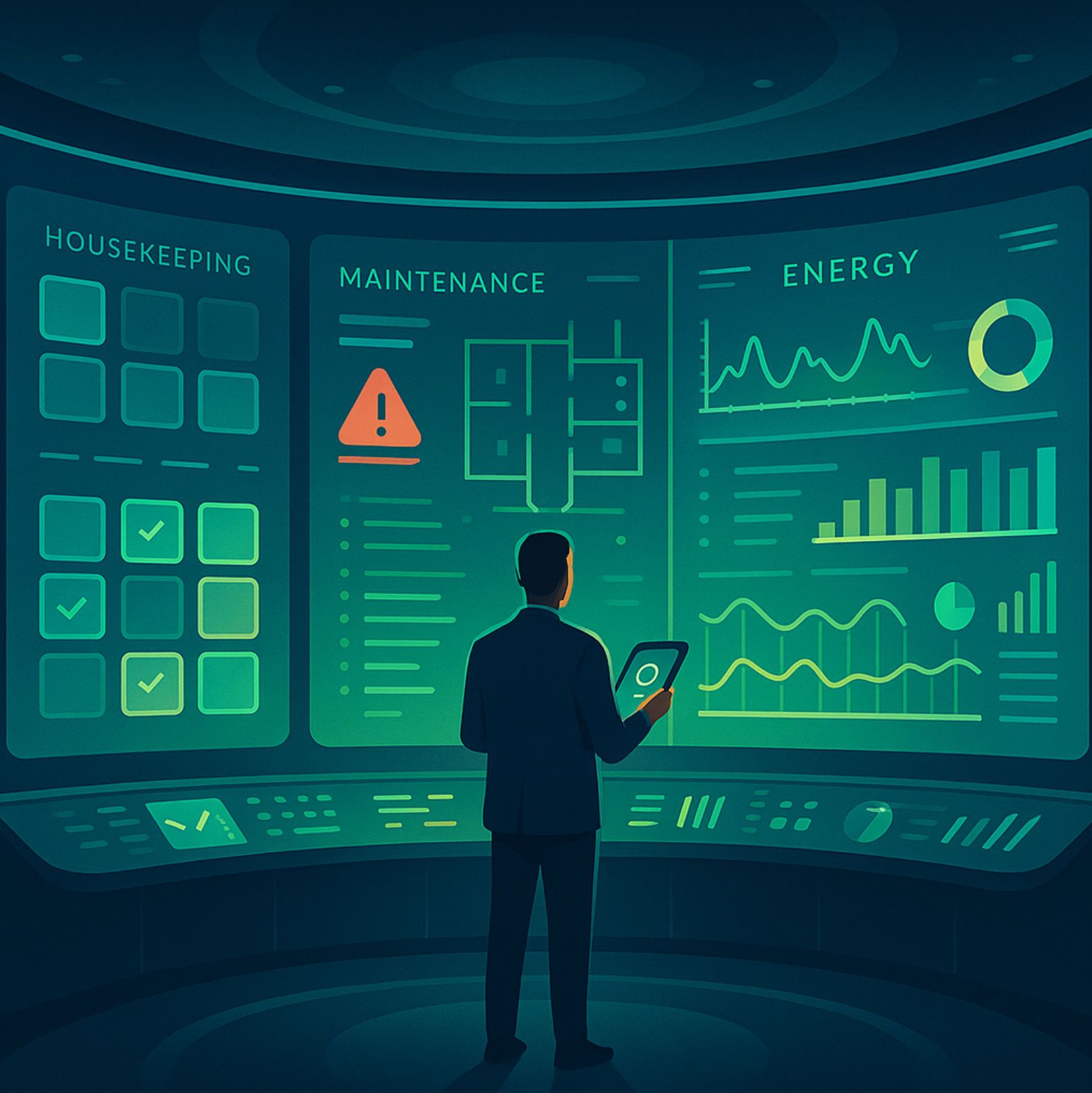
✅ Hashtags
#MobileAppDevelopment
#StafflessHotel
#HotelApp
#ContactlessCheckIn
#HotelTech
#SmartLocks
#IoT
Other articles
Custom App Development for Smart Hydroponic Gardens Controlled-environment agriculture is booming, yet success hinges on software that can orchestrate pumps, LEDs, nutrients, and climate in real time. In this in-depth guide A-Bots.com walks you through the full technology stack—hardware, edge intelligence, secure connectivity, cloud analytics, and UX—showing how each layer compounds into measurable savings. You’ll see case data on 90 % water reduction, 20 % yield gains, and pay-back periods as short as 26 months, plus a four-stage methodology that de-risks everything from proof-of-concept to fleet-scale OTA updates. Whether you’re a rooftop startup or an appliance manufacturer, learn how bespoke app development transforms a hydroponic rack into a transparent, investor-ready food engine—and why the next billion city dwellers will eat produce grown by code.
Agriculture App Development for Farmers In 2024, U.S. farmers are more connected than ever — with 82% using smartphones and 85% having internet access. This article explores how mobile applications are transforming everyday operations, from drone-guided field scouting to livestock health tracking and predictive equipment maintenance. It examines why off-the-shelf apps often fail to address specific farm needs and how collaborative, farmer-funded app development is gaining momentum. Through real-world examples and step-by-step guidance, readers will learn how communities of growers can fund, design, and launch custom apps that fit their exact workflows. A-Bots.com offers tailored development services that support both solo farmers and agricultural groups. With offline capabilities, modular design, and support for U.S. and international compliance, these apps grow alongside the farm. Whether you're planting soybeans in Iowa, raising cattle in Texas, or running a greenhouse in California — this article offers the tools and inspiration to build your own farm technology. Discover why more farmers are saying: we don’t wait for the future — we build it.
App Development for Elder-Care The world is aging faster than care workforces can grow. This long-read explains why fall-detection wearables, connected pill dispensers, conversational interfaces and social robots are no longer stand-alone gadgets but vital nodes in an integrated elder-safety network. Drawing on market stats, clinical trials and real-world pilots, we show how A-Bots.com stitches these modalities together through a HIPAA-compliant mobile platform that delivers real-time risk scores, family peace of mind and senior-friendly design. Perfect for device makers, healthcare providers and insurers seeking a turnkey path to scalable, human-centric aging-in-place solutions.
Offline AI Agent for Everyone A-Bots.com is about to unplug AI from the cloud. Our upcoming solar-ready mini-computer runs large language and vision models entirely on device, pairs with any phone over Wi-Fi, and survives on a power bank. Pre-orders open soon—edge intelligence has never been this independent.
Custom Drone Software Mastery - ArduPilot and MissionPlanner This long-read unpacks the commercial drone boom, then dives into the technical backbone of ArduPilot and Mission Planner—one open, multi-domain codebase and a ground station that doubles as a full-stack lab. From rapid-prototype firmware to data-driven optimisation retainers, A-Bots.com shows how disciplined codecraft delivers measurable wins: 40 % fewer mission aborts, 70% faster surveys, and faster BVLOS approvals. Finally, the article looks ahead to AI-augmented navigation, Kubernetes-coordinated swarms and satellite-linked control channels, detailing the partnerships and R&D milestones that will shape autonomous, multi-domain operations through 2034. Read on to see why enterprises choose A-Bots.com to turn ambitious flight plans into certified, revenue-earning reality.
Snack-to-Stardom App: Gamified Promo for Chips and Snacks This long-read unpacks the Snack-to-Stardom blueprint—an end-to-end mobile platform where consumers scan a chip bag, unlock AR quests, stream branded challenges and graduate from ‘snacker’ to ‘creator’ in exchange for guaranteed rewards. Grounded in market figures that trace a USD 142 billion snack sector and a USD 100 billion mobile-gaming landscape, it stitches together lessons from Doritos, Pringles and Starbucks loyalty roll-outs to prove that gamified apps out-perform traditional coupon drives. Readers tour the architecture: Flutter front-end, GraphQL core, PlayFab leaderboards and ML content moderation; then see how A-Bots.com compresses this stack into a ten-week go-live. The result is a replicable flywheel that converts scans into recurring purchases, live-stream impressions and monetisable data—turning every crunch into measurable ROI. From engagement metrics to revenue multipliers, the piece equips brand leaders with a clear, data-backed case for why now is the moment to fuse snacking with the creator economy.
Top stories
Copyright © Alpha Systems LTD All rights reserved.
Made with ❤️ by A-BOTS
